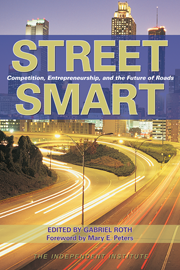Last month, the Amtrak Reform Council (ARC) released its recommendations for restructuring the National Railroad Passenger Corporation, better known as Amtrak, the nation’s beleaguered intercity passenger rail service. The ARC is an independent federal commission Congress created five years ago to help Amtrak reach financial self-sufficiency—a goal the railroad has never reached in its 31-year money-losing history.
Unfortunately, the ARC’s itinerary misses its intended destination. If Congress adopts the ARC’s recommendations, billions of taxpayer dollars would be wasted on a superseded mode of transportation that carries about one-half of 1 percent of person-travel in the U.S., at costs that passengers themselves consider prohibitive.
One ARC proposal makes sense: outsourcing Amtrak services to private-sector rail operators, who would bid for the right to run individual routes. By recognizing the benefits of competition, this proposal runs counter to the profligate spirit that has let Amtrak burn some $25 billion in federal subsidies since its creation in 1971.
But the ARC plan avoids restructuring Amtrak where it matters most.
First, the plan proposes that Amtrak continue to provide money-losing services—with the help of federal and state subsidies. Amtrak says it needs $1.2 billion or it will halt the money-losing lines this October. The ARC’s plan recommends indefinite federal subsidies for capital expenses and even for “long-distance ‘national’ trains.”
As for non-“national” trains, the report recommends that “states would bear the costs of operating subsidies for corridor services.”
Congress deserves much of the blame for Amtrak’s losses. Under the Amtrak Reform and Accountability Act of 1997, the same legislation that created the ARC, Amtrak was required to submit a plan for its own liquidation if it could not achieve operational self-sufficiency by Dec. 2, 2001. But, after it was clear that Amtrak could not meet this deadline, Congress got cold feet and (in an unpublicized amendment to a defense-spending bill) forbade Amtrak from preparing a liquidation plan.
The ARC’s plan would also relieve Amtrak of the responsibility for covering its own infrastructure expenses. The ARC suggests that government should finance rail infrastructure because it finances roads and airports. This suggestion is based on error, as roads and airports are generally financed out of dedicated funds, paid for by those who use the services.
But perhaps the biggest problem with the ARC report is its assertion that, profitable or not, “there should be a bright future for passenger rail service in America.” When the Nixon administration sold Amtrak to the public it emphasized that Amtrak would be self-sustaining by its third birthday. Apparently, the nation’s travelers have not been as interested as the Nixon administration had hoped.
Could private firms provide passenger-rail service at a profit? Possibly. In 1997, before Congress gave Amtrak its five-year bailout, Guilford Transportation Industries wrote to the Department of Transportation seeking to negotiate the right “to purchase or lease the rail line and operate private passenger service throughout the [“Northeast”] corridor.”
Private companies are reported to provide profitable rail passenger service in Australia, Japan and New Zealand. But the possibility that some routes could be provided without subsidy does not justify government subsidy of others.
Subsidies to passenger rail services are particularly damaging to their competitors, namely airlines and bus companies. Until Sept. 11, airlines generally paid their way, and are expected to do so again. American and Canadian motor coaches carried—without subsidy—860 million passengers in 1999, 38 times the number of Amtrak passengers for that year. When operating on freeways or on their own right-of-way, motor coaches can offer comparable service to rail, and at lower costs.
Why should these tax-paying carriers be forced to subsidize competition by rail service? The bottom line is that travel by rail is nice for some, but if those who choose to take the train refuse to pay the costs, why should taxpayers fund it?









